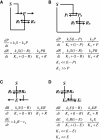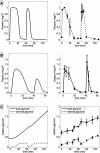A systems biology analysis of long and short-term memories of osmotic stress adaptation in fungi
- PMID: 22631601
- PMCID: PMC3434031
- DOI: 10.1186/1756-0500-5-258
A systems biology analysis of long and short-term memories of osmotic stress adaptation in fungi
Abstract
Background: Saccharomyces cerevisiae senses hyperosmotic conditions via the HOG signaling network that activates the stress-activated protein kinase, Hog1, and modulates metabolic fluxes and gene expression to generate appropriate adaptive responses. The integral control mechanism by which Hog1 modulates glycerol production remains uncharacterized. An additional Hog1-independent mechanism retains intracellular glycerol for adaptation. Candida albicans also adapts to hyperosmolarity via a HOG signaling network. However, it remains unknown whether Hog1 exerts integral or proportional control over glycerol production in C. albicans.
Results: We combined modeling and experimental approaches to study osmotic stress responses in S. cerevisiae and C. albicans. We propose a simple ordinary differential equation (ODE) model that highlights the integral control that Hog1 exerts over glycerol biosynthesis in these species. If integral control arises from a separation of time scales (i.e. rapid HOG activation of glycerol production capacity which decays slowly under hyperosmotic conditions), then the model predicts that glycerol production rates elevate upon adaptation to a first stress and this makes the cell adapts faster to a second hyperosmotic stress. It appears as if the cell is able to remember the stress history that is longer than the timescale of signal transduction. This is termed the long-term stress memory. Our experimental data verify this. Like S. cerevisiae, C. albicans mimimizes glycerol efflux during adaptation to hyperosmolarity. Also, transient activation of intermediate kinases in the HOG pathway results in a short-term memory in the signaling pathway. This determines the amplitude of Hog1 phosphorylation under a periodic sequence of stress and non-stressed intervals. Our model suggests that the long-term memory also affects the way a cell responds to periodic stress conditions. Hence, during osmohomeostasis, short-term memory is dependent upon long-term memory. This is relevant in the context of fungal responses to dynamic and changing environments.
Conclusions: Our experiments and modeling have provided an example of identifying integral control that arises from time-scale separation in different processes, which is an important functional module in various contexts.
Figures










Similar articles
-
Activation of the Hog1 MAPK by the Ssk2/Ssk22 MAP3Ks, in the absence of the osmosensors, is not sufficient to trigger osmostress adaptation in Saccharomyces cerevisiae.FEBS J. 2018 Mar;285(6):1079-1096. doi: 10.1111/febs.14385. Epub 2018 Jan 30. FEBS J. 2018. PMID: 29341399
-
Initiation of the transcriptional response to hyperosmotic shock correlates with the potential for volume recovery.FEBS J. 2013 Aug;280(16):3854-67. doi: 10.1111/febs.12382. Epub 2013 Jul 5. FEBS J. 2013. PMID: 23758973
-
Histatin 5 initiates osmotic stress response in Candida albicans via activation of the Hog1 mitogen-activated protein kinase pathway.Eukaryot Cell. 2007 Oct;6(10):1876-88. doi: 10.1128/EC.00039-07. Epub 2007 Aug 22. Eukaryot Cell. 2007. PMID: 17715369 Free PMC article.
-
Yeast osmoregulation.Methods Enzymol. 2007;428:29-45. doi: 10.1016/S0076-6879(07)28002-4. Methods Enzymol. 2007. PMID: 17875410 Review.
-
Stress-Activated Protein Kinases in Human Fungal Pathogens.Front Cell Infect Microbiol. 2019 Jul 17;9:261. doi: 10.3389/fcimb.2019.00261. eCollection 2019. Front Cell Infect Microbiol. 2019. PMID: 31380304 Free PMC article. Review.
Cited by
-
Sfp1 and Rtg3 reciprocally modulate carbon source-conditional stress adaptation in the pathogenic yeast Candida albicans.Mol Microbiol. 2017 Aug;105(4):620-636. doi: 10.1111/mmi.13722. Epub 2017 Jun 19. Mol Microbiol. 2017. PMID: 28574606 Free PMC article.
-
Cellular forgetting, desensitisation, stress and ageing in signalling networks. When do cells refuse to learn more?Cell Mol Life Sci. 2024 Feb 19;81(1):97. doi: 10.1007/s00018-024-05112-7. Cell Mol Life Sci. 2024. PMID: 38372750 Free PMC article. Review.
-
Stress adaptation in a pathogenic fungus.J Exp Biol. 2014 Jan 1;217(Pt 1):144-55. doi: 10.1242/jeb.088930. J Exp Biol. 2014. PMID: 24353214 Free PMC article. Review.
-
Mechanisms underlying the exquisite sensitivity of Candida albicans to combinatorial cationic and oxidative stress that enhances the potent fungicidal activity of phagocytes.mBio. 2014 Jul 15;5(4):e01334-14. doi: 10.1128/mBio.01334-14. mBio. 2014. PMID: 25028425 Free PMC article.
-
Global Epitranscriptomics Profiling of RNA Post-Transcriptional Modifications as an Effective Tool for Investigating the Epitranscriptomics of Stress Response.Mol Cell Proteomics. 2016 Mar;15(3):932-44. doi: 10.1074/mcp.M115.054718. Epub 2016 Jan 5. Mol Cell Proteomics. 2016. PMID: 26733207 Free PMC article.
References
Publication types
MeSH terms
Substances
Grants and funding
LinkOut - more resources
Full Text Sources
Molecular Biology Databases

